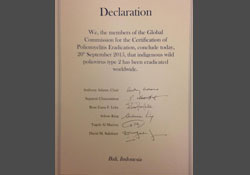World Polio Day highlights progress and concerns in the final stretch to polio eradication

Rotary International
World Polio Day celebrates the achievements of countless immunization champions around the world who are working to put polio in the past. This year, there is much to celebrate. On World Polio Day, 24 October 2015, WHO/Europe joins its partners in celebrating historical landmarks realized in 2015 and also in raising awareness about the potential risks to the eradication programme in currently polio-free countries and regions.
Eradication of type 2 wild poliovirus
Wild poliovirus type 2 is no longer a threat to children anywhere in the world. Eradication of type 2, declared on 20 September 2015, represents a major step forwards in the global effort to eradicate all three wild poliovirus serotypes.
Through the active commitment of all stakeholders, the Region has contributed to global eradication of wild poliovirus type 2. The last case of wild poliovirus type 2 in the WHO European Region was reported in Azerbaijan in 1996, and the last case reported globally was detected in India in 1999. Once eradication of all three polio strains has been achieved, it will represent only the second time in history that a human disease has been eradicated, after smallpox.
11 August 2015 marked 1 year without a confirmed case of any type of wild poliovirus on the African continent, for the first time in history. Only 2 countries in the world remain endemic for the disease: Afghanistan and Pakistan.
Polio in the WHO European Region
The WHO European Region was declared polio-free in 2002. Retaining this status is one of the primary goals of the European Vaccine Action Plan, recently endorsed by all European countries. WHO/Europe actively supports Member States in strengthening surveillance and in improving the quality of immunization programmes. Building capacity to respond to outbreaks is also crucial, and WHO/Europe therefore organizes polio outbreak simulation exercises to help Member States review and update their national response plans.
The Region has retained its polio-free status since 2002, despite several importations of the virus into the Region.
Rising concern
The recent detection of two cases of polio in Ukraine, however, is a stark reminder that historical gains in global prevention and control of polio remain fragile.
On rare occasions, where immunization coverage is very low, excreted vaccine virus can continue to circulate and genetically change into a form that can paralyse underimmunized children. So far this year, 5 countries across the globe, including Ukraine, have detected 1 or more cases of circulating vaccine-derived poliovirus (cVDPV).
In accordance with international outbreak guidelines and protocols, the detection of cVDPV constitutes an outbreak requiring an urgent response. Since confirmation of the outbreak in Ukraine on 1 September 2015, WHO and the United Nations Children's Fund (UNICEF) have been providing the Ministry of Health with both technical and on-site support to plan large-scale supplementary vaccination activities, strengthen poliovirus surveillance and train health workers to answer questions about the vaccine and to administer it.
A nationwide immunization campaign was launched by the Ministry of Health of Ukraine on 21 October 2015 to target all children up to 6 years of age in the first two rounds and all children up to 10 years of age in the third round.
Ongoing effort
Sustained momentum and vigilance are needed in the WHO European Region and the world to reach every last child with life-saving polio vaccines and be prepared for possible outbreaks, until global eradication is complete.



